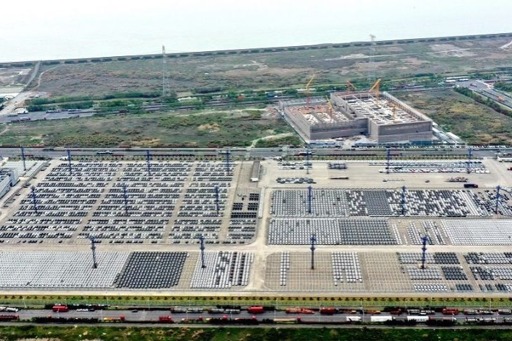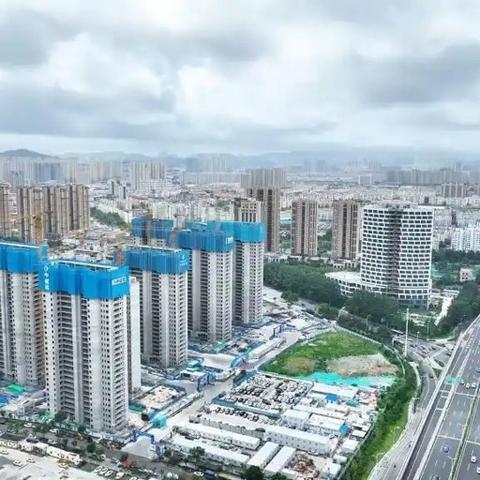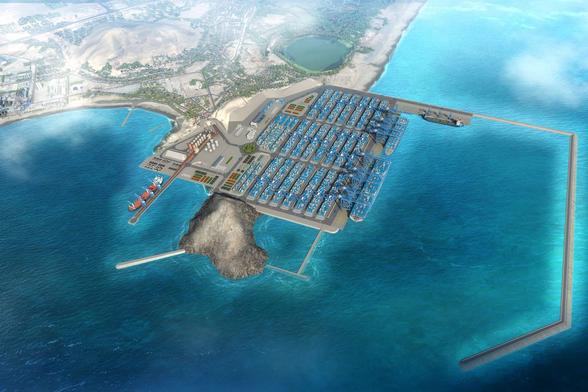🇨🇳 ¡La #blockchain se expande en #China!
NVIDIA pierde su dominio en el mercado de hardware de IA en China por restricciones de exportación
Esto solo demuestra que las sanciones no frenan el avance tecnológico, sino que fuerzan a China a ser autosuficiente. La pérdida de NVIDIA puede marcar el auge de un poder tecnológico propio en un mercado que ya no depende de EE. UU. Ni un paso atrás.
China's centrally administered State-owned enterprises are increasingly seen as not only pioneers in going global but also anchors of industrial security and rule-shaping

China's centrally administered State-owned enterprises are increasingly seen as not only pioneers in going global but also anchors of industrial security and rule-shaping - Lemmygrad
China’s centrally administered State-owned enterprises are increasingly seen as not only pioneers in going global but also anchors of industrial security and rule-shaping, with their push into higher-value exports and overseas green-energy investment bolstering resilience across supply chains, experts said. With the rapid advancement of China’s economy and industrialization, more Chinese enterprises are seeking overseas markets. According to the Planning and Development Bureau of the State-owned Assets Supervision and Administration Commission of the State Council, SOEs now have a presence in more than 180 countries, with over 10,000 projects and institutions. In parallel, SOEs are going global in collaboration with enterprises under diverse ownership structures, partnering with local State-owned and private firms in industrial parks, energy and power, and communications and information. Beyond scale, experts noted that the international competitiveness of Chinese products and the resilience of supply chains provide a favorable backdrop for the overseas operations of SOEs. This competitiveness, they said, can support the stability and smooth functioning of global industrial and supply chains amid rising protectionism and unilateralism. As one of the earliest enterprises to venture abroad since China’s reform and opening-up, China Information and Communication Technologies Group has focused on three pillars: strengthening technology innovation for global markets, building localized marketing capabilities, and advancing localized overseas production and manufacturing. Its international competitiveness and influence have steadily grown. Reviewing CICT’s internationalization, He Shuping, president of CICT, said the company must keep refining its products to bolster differentiated advantages. He added that CICT regards standards development and patent portfolio building as key to competitiveness, having led the formulation and revision of 65 ITU (International Telecommunication Union) standards. Today, CICT ranks among the global top five by market share for core product lines, including optical fiber and cable, optical components, and optical access. Against a complex external environment, experts also observe an export structure upgrading toward new and higher-quality products. Exports of electromechanical goods and the “new trio” — electric vehicles, solar batteries and lithium-ion batteries — as well as green equipment such as electric locomotives, have maintained solid growth, indicating sustained momentum for industrial upgrading and demand for green, digital infrastructure. At the same time, policy and market headwinds persist. According to Lyu Daliang, spokesperson and director of the Department of Statistics and Analysis of the General Administration of Customs, abuses of tariffs by certain countries have undermined the multilateral trading system and disrupted normal production and trade. Even so, China remains committed to supporting and upholding multilateralism and promoting the stability and smooth flow of global industrial and supply chains, Lyu said. Apart from high-quality exports, China has in recent years emphasized green energy investment and the sustainable development of overseas markets, said Xie Laihui, executive director of the division of Belt and Road studies at the National Institute of International Strategy under the Chinese Academy of Social Sciences. Since declaring in 2021 that it would no longer build new coal-fired power projects abroad, China has progressively shifted its overseas energy investment focus toward supporting developing countries in their green energy transitions. In Xie’s view, Chinese SOEs’ overseas green-energy push has distinct features. First, complete supply and industrial chains with a full range of technologies enable end-to-end solutions from production to consumption for partner countries. Second, projects are tailored to local conditions — choosing among solar, wind, and hydropower based on each country’s resource endowment — while cooperation structures offer strong price advantages suited to developing countries’ fiscal capacity, accelerating technology diffusion. Xie said both China’s traditional and new energy companies, under the Green Silk Road framework, are expanding overseas and using investment to spur energy transitions in Belt and Road partner countries, advancing clean-energy uptake and emission cuts while, to a degree, strengthening energy security. Such a model offers developing countries cost-controlled, locally tailored pathways for energy development, helping foster a virtuous cycle toward energy transition, energy security, and carbon neutrality, Xie said.
As China's decade-long property market boom cools, policymakers are steering the world's second-largest economy toward a more sustainable alternative — revitalizing aging cities.

As China's decade-long property market boom cools, policymakers are steering the world's second-largest economy toward a more sustainable alternative — revitalizing aging cities. - Lemmygrad
As China’s decade-long property market boom cools, policymakers are steering the world’s second-largest economy toward a more sustainable alternative — revitalizing aging cities. By positioning urban renewal as a key strategy to stimulate domestic demand, Beijing is calibrating growth drivers while addressing deep-seated social needs, experts and executives said. Investment aimed at breathing new life into dilapidated residential areas, obsolete industrial sites, and underutilized public spaces will translate into substantial demand for various industries, increased values for existing assets and a notable upgrade for the urban environment, they added. Their comments came after the country’s top leadership has elevated urban renewal to a systematic growth pillar during high-level tone-setting meetings, prioritizing maximizing the use of existing facilities over large-scale expansion. President Xi Jinping highlighted that China’s urbanization is evolving from rapid growth to stable development, and urban development is shifting from a stage of large-scale expansion to one focused on improving the quality and efficiency of existing urban areas, during the Central Urban Work Conference in mid-July. Over the past few decades, China has experienced the largest and fastest urbanization process in human history. According to the National Bureau of Statistics, its urbanization rate, which measures the ratio of permanent urban residents relative to the total population, reached 67 percent last year. Two weeks later, Xi, who is also general secretary of the Communist Party of China Central Committee, reiterated the need to promote urban renewal in a high-quality manner at a meeting held by the Political Bureau of the CPC Central Committee when mapping out priorities for economic work in the second half of the year. The Ministry of Housing and Urban-Rural Development pledged in December to try to complete the renovation of aging urban residential communities built before the end of 2000 by the year 2025. “By 2030, over 10 billion square meters of residential buildings will be more than 30 years old, and even if we only renovate 10 percent of that each year, that’s still 1 billion square meters,” said Zhao Yanjing, a professor specialized in urban economics at Xiamen University. To put this into perspective, the total new construction area nationwide last year, according to data from the National Bureau of Statistics, was less than 740 million square meters, and even at the peak in 2019, it stood at some 1.67 billion square meters. Even at such a pace, the aging residential buildings would require at least a decade to address, by which time even more properties will come to the stage where reconditioning work is needed, Zhao said. “This means that as the real estate market shifts from a focus on constructing new houses to enhancing existing ones, the overall market size will likely be fairly large,” Zhao said. “These renewal projects will generate substantial economic activity, helping to offset the slowdown in the real estate market, while also improving the living conditions of our citizens.” From 2019 to 2024, China renovated 280,000 aging residential communities, benefiting more than 120 million people, data from the ministry showed. China’s urban renewal initiatives have moved beyond the mere renovation of old residential communities. Abandoned factories become innovation hubs; dormant warehouses are transformed into cultural venues; and urban villages are retrofitted into affordable housing zones. “As the country moves away from a growth model centered on new construction, the ability to extract value from our existing facilities will become increasingly important,” said Yang Baojun, president of the Urban Planning Society of China and former chief economist of the Ministry of Housing and Urban-Rural Development. In Wuxi, Jiangsu province, an urban renewal initiative, which began in 2019, has transformed a patchwork of industrial remnants, including a textile factory and an ironworks, into a multifunctional hub blending tech industry, digital culture and community spaces. The industrial park has so far attracted over 100 enterprises, generating annual tax contributions exceeding 15 million yuan ($2.1 million), according to local authorities. “Urban renewal is no longer about demolition,” Yang said. It’s about reprogramming urban DNA economically, socially and functionally." Chinese cities are sitting on a gold mine of undervalued assets. The key is to find innovative ways to activate and repurpose these existing resources, rather than constantly pursue new development, Yang added. In April, the Ministry of Finance pledged fiscal support for urban renewal projects in up to 20 cities this year, prioritizing megacities, superlarge cities and key urban centers along the Yellow and Pearl rivers. Centrally administered municipalities and cities in the country’s western regions qualify for subsidies of up to 1.2 billion yuan each. Cities in central regions may receive up to 1 billion yuan, while those in eastern regions are eligible for up to 800 million yuan. However, experts cautioned that the scale and complexity of these urban renewal projects are such that government funding alone is simply not enough. Attracting private investment will be crucial to the long-term sustainability of such initiatives. Dong Yu, executive vice-president of Tsinghua University’s China Institute for Development Planning, said: “These projects require substantial up-front investments and can take years to complete. For private enterprises to get involved, there needs to be a viable business model offering reasonable and stable returns.” China issued a guideline in mid-May to increase policy and financial support for urban renewal projects, vowing to establish a sustainable urban renewal model that is government-led, market-driven and publicly engaged. Localities can explore the “public-private partnership plus concession” approach, in which the government grants private enterprises long-term operating rights over ancillary facilities, such as parking lots and charging stations, in the vicinity of the urban renewal sites, Dong said. In the Fuli residential community in Pingxiang, Jiangxi province, property management fees and parking fees now serve as a reliable source of income for renewal project developers. The project has focused on core infrastructure upgrades, such as road paving and utility network renovations, as well as the expansion and enhancement of parking facilities, said Yang Qian, general manager of Boyue Construction and Development Co. The Jiangxi provincial branch of China Development Bank has been involved from the beginning, providing 10 million yuan in long-term loans to support the project. More importantly, its financing model incorporates user fees as potential revenue sources, Yang said.
Bemühungen, um von der fossilen Energie weg zu kommen, sind grundsätzlich zu begrüßen. Allerdings nur, wenn dabei nicht Kollateralschäden in anderen Regionen der Welt entstehen. Genau dies ist aber der Fall bei Chinas Energiewende, da das Land dafür #Rohstoffe wie Kupfer aus Peru importiert, die dort große soziale und ökologische Schäden anrichten.
https://www.infostelle-peru.de/wirtschaft-und-bergbau/chinas-energiewandel-und-die-auswirkungen-in-peru/

Chinas Energiewende und die Auswirkungen in Peru | Informationsstelle Peru e.V.
Bemühungen, um von der fossilen Energie weg zu kommen, sind grundsätzlich zu begrüßen. Allerdings nur, wenn dabei nicht Kollateralschäden in anderen Regionen der Welt entstehen. Genau dies ist aber der Fall bei Chinas Energiewende, da das Land dafür Rohstoffe wie Kupfer aus Peru importiert, die dort große soziale und ökologische Schäden anrichten.





